Business Administration Report: M&S Operations and Management
VerifiedAdded on 2020/06/04
|21
|5095
|303
Report
AI Summary
This report provides a comprehensive overview of business administration, using Marks and Spencer (M&S) as a case study. It covers various units, including developing presentations, managing office facilities, handling mail, providing administrative support for meetings, and using spreadsheet software and email. The report discusses best practices for presentations, communication media, office management processes, and methods for managing constraints. It also delves into mail handling procedures, organizational policies, and meeting support, including attendance strategies and resource setup. The report integrates various business administration concepts to analyze the operational aspects of M&S, offering insights into retail management and administrative functions. The report covers the introduction, conclusion and references.
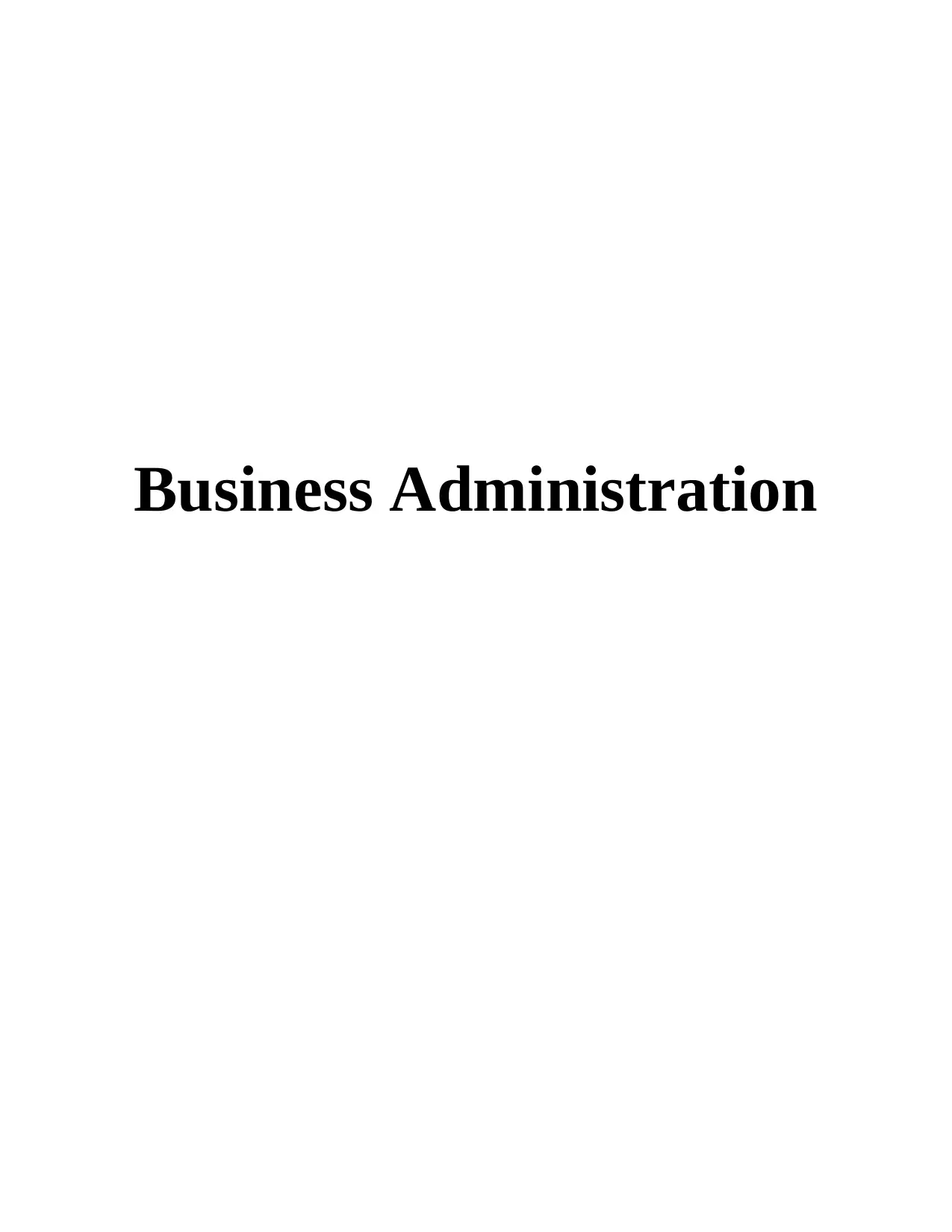
Business Administration
Paraphrase This Document
Need a fresh take? Get an instant paraphrase of this document with our AI Paraphraser
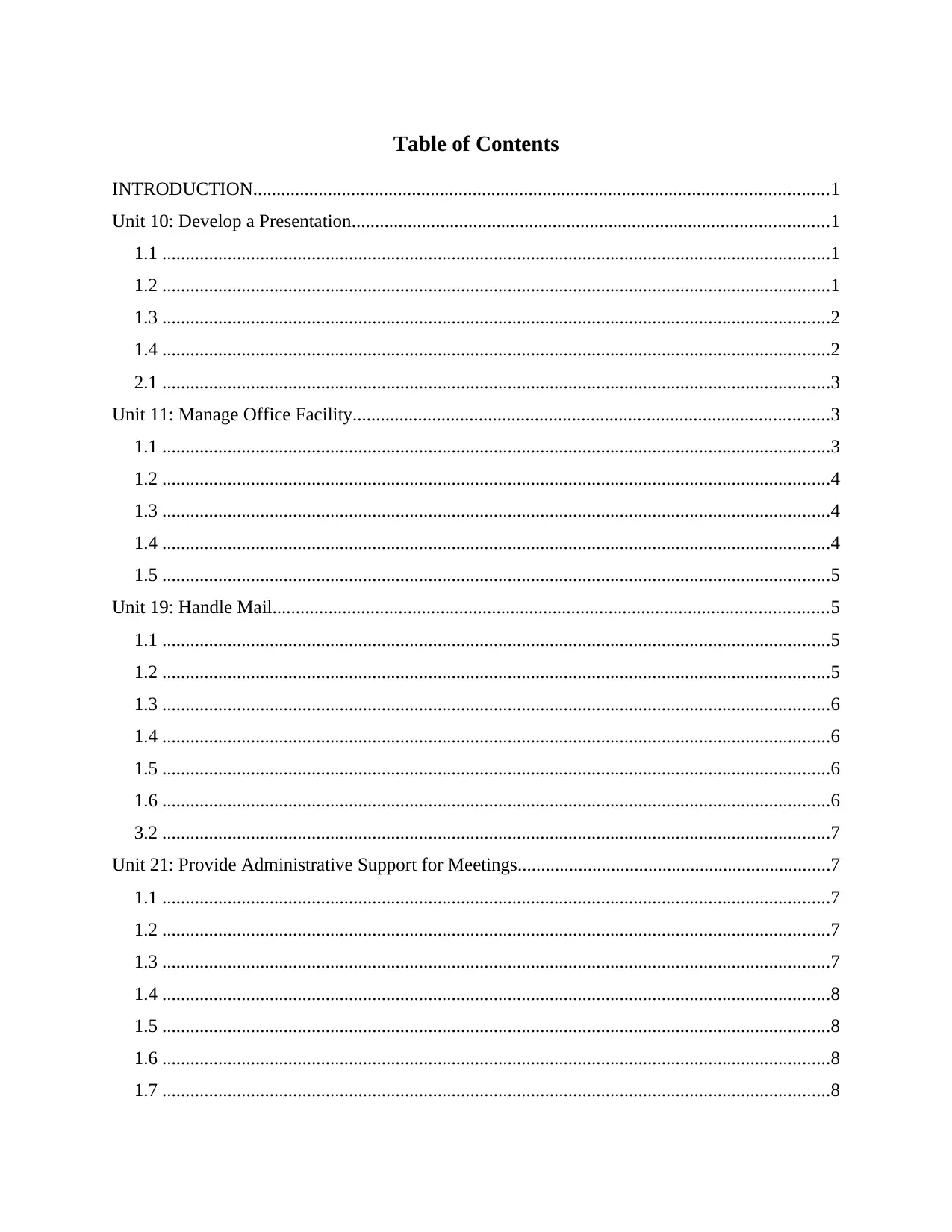
Table of Contents
INTRODUCTION...........................................................................................................................1
Unit 10: Develop a Presentation......................................................................................................1
1.1 ...............................................................................................................................................1
1.2 ...............................................................................................................................................1
1.3 ...............................................................................................................................................2
1.4 ...............................................................................................................................................2
2.1 ...............................................................................................................................................3
Unit 11: Manage Office Facility......................................................................................................3
1.1 ...............................................................................................................................................3
1.2 ...............................................................................................................................................4
1.3 ...............................................................................................................................................4
1.4 ...............................................................................................................................................4
1.5 ...............................................................................................................................................5
Unit 19: Handle Mail.......................................................................................................................5
1.1 ...............................................................................................................................................5
1.2 ...............................................................................................................................................5
1.3 ...............................................................................................................................................6
1.4 ...............................................................................................................................................6
1.5 ...............................................................................................................................................6
1.6 ...............................................................................................................................................6
3.2 ...............................................................................................................................................7
Unit 21: Provide Administrative Support for Meetings...................................................................7
1.1 ...............................................................................................................................................7
1.2 ...............................................................................................................................................7
1.3 ...............................................................................................................................................7
1.4 ...............................................................................................................................................8
1.5 ...............................................................................................................................................8
1.6 ...............................................................................................................................................8
1.7 ...............................................................................................................................................8
INTRODUCTION...........................................................................................................................1
Unit 10: Develop a Presentation......................................................................................................1
1.1 ...............................................................................................................................................1
1.2 ...............................................................................................................................................1
1.3 ...............................................................................................................................................2
1.4 ...............................................................................................................................................2
2.1 ...............................................................................................................................................3
Unit 11: Manage Office Facility......................................................................................................3
1.1 ...............................................................................................................................................3
1.2 ...............................................................................................................................................4
1.3 ...............................................................................................................................................4
1.4 ...............................................................................................................................................4
1.5 ...............................................................................................................................................5
Unit 19: Handle Mail.......................................................................................................................5
1.1 ...............................................................................................................................................5
1.2 ...............................................................................................................................................5
1.3 ...............................................................................................................................................6
1.4 ...............................................................................................................................................6
1.5 ...............................................................................................................................................6
1.6 ...............................................................................................................................................6
3.2 ...............................................................................................................................................7
Unit 21: Provide Administrative Support for Meetings...................................................................7
1.1 ...............................................................................................................................................7
1.2 ...............................................................................................................................................7
1.3 ...............................................................................................................................................7
1.4 ...............................................................................................................................................8
1.5 ...............................................................................................................................................8
1.6 ...............................................................................................................................................8
1.7 ...............................................................................................................................................8
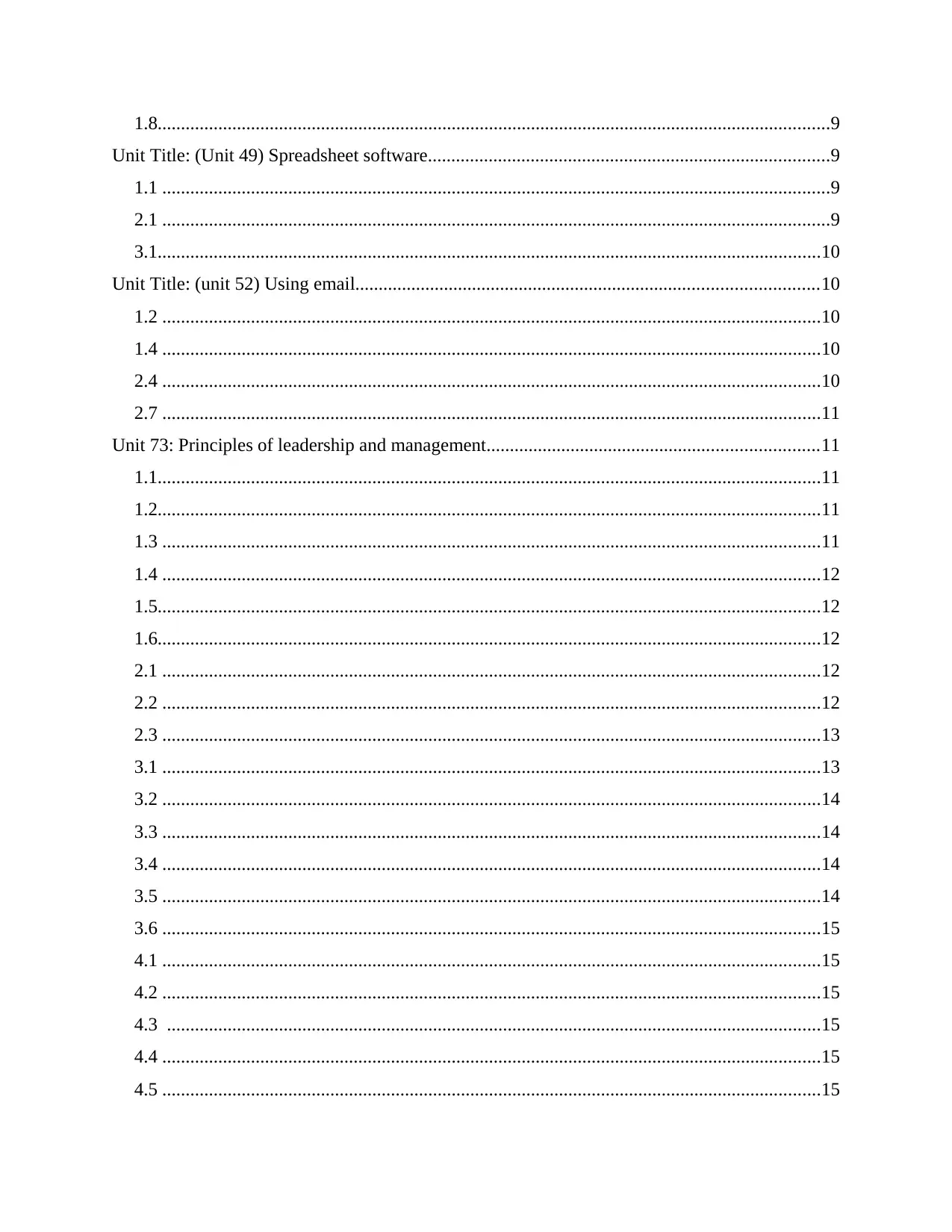
1.8................................................................................................................................................9
Unit Title: (Unit 49) Spreadsheet software......................................................................................9
1.1 ...............................................................................................................................................9
2.1 ...............................................................................................................................................9
3.1..............................................................................................................................................10
Unit Title: (unit 52) Using email...................................................................................................10
1.2 .............................................................................................................................................10
1.4 .............................................................................................................................................10
2.4 .............................................................................................................................................10
2.7 .............................................................................................................................................11
Unit 73: Principles of leadership and management.......................................................................11
1.1..............................................................................................................................................11
1.2..............................................................................................................................................11
1.3 .............................................................................................................................................11
1.4 .............................................................................................................................................12
1.5..............................................................................................................................................12
1.6..............................................................................................................................................12
2.1 .............................................................................................................................................12
2.2 .............................................................................................................................................12
2.3 .............................................................................................................................................13
3.1 .............................................................................................................................................13
3.2 .............................................................................................................................................14
3.3 .............................................................................................................................................14
3.4 .............................................................................................................................................14
3.5 .............................................................................................................................................14
3.6 .............................................................................................................................................15
4.1 .............................................................................................................................................15
4.2 .............................................................................................................................................15
4.3 ............................................................................................................................................15
4.4 .............................................................................................................................................15
4.5 .............................................................................................................................................15
Unit Title: (Unit 49) Spreadsheet software......................................................................................9
1.1 ...............................................................................................................................................9
2.1 ...............................................................................................................................................9
3.1..............................................................................................................................................10
Unit Title: (unit 52) Using email...................................................................................................10
1.2 .............................................................................................................................................10
1.4 .............................................................................................................................................10
2.4 .............................................................................................................................................10
2.7 .............................................................................................................................................11
Unit 73: Principles of leadership and management.......................................................................11
1.1..............................................................................................................................................11
1.2..............................................................................................................................................11
1.3 .............................................................................................................................................11
1.4 .............................................................................................................................................12
1.5..............................................................................................................................................12
1.6..............................................................................................................................................12
2.1 .............................................................................................................................................12
2.2 .............................................................................................................................................12
2.3 .............................................................................................................................................13
3.1 .............................................................................................................................................13
3.2 .............................................................................................................................................14
3.3 .............................................................................................................................................14
3.4 .............................................................................................................................................14
3.5 .............................................................................................................................................14
3.6 .............................................................................................................................................15
4.1 .............................................................................................................................................15
4.2 .............................................................................................................................................15
4.3 ............................................................................................................................................15
4.4 .............................................................................................................................................15
4.5 .............................................................................................................................................15
⊘ This is a preview!⊘
Do you want full access?
Subscribe today to unlock all pages.

Trusted by 1+ million students worldwide
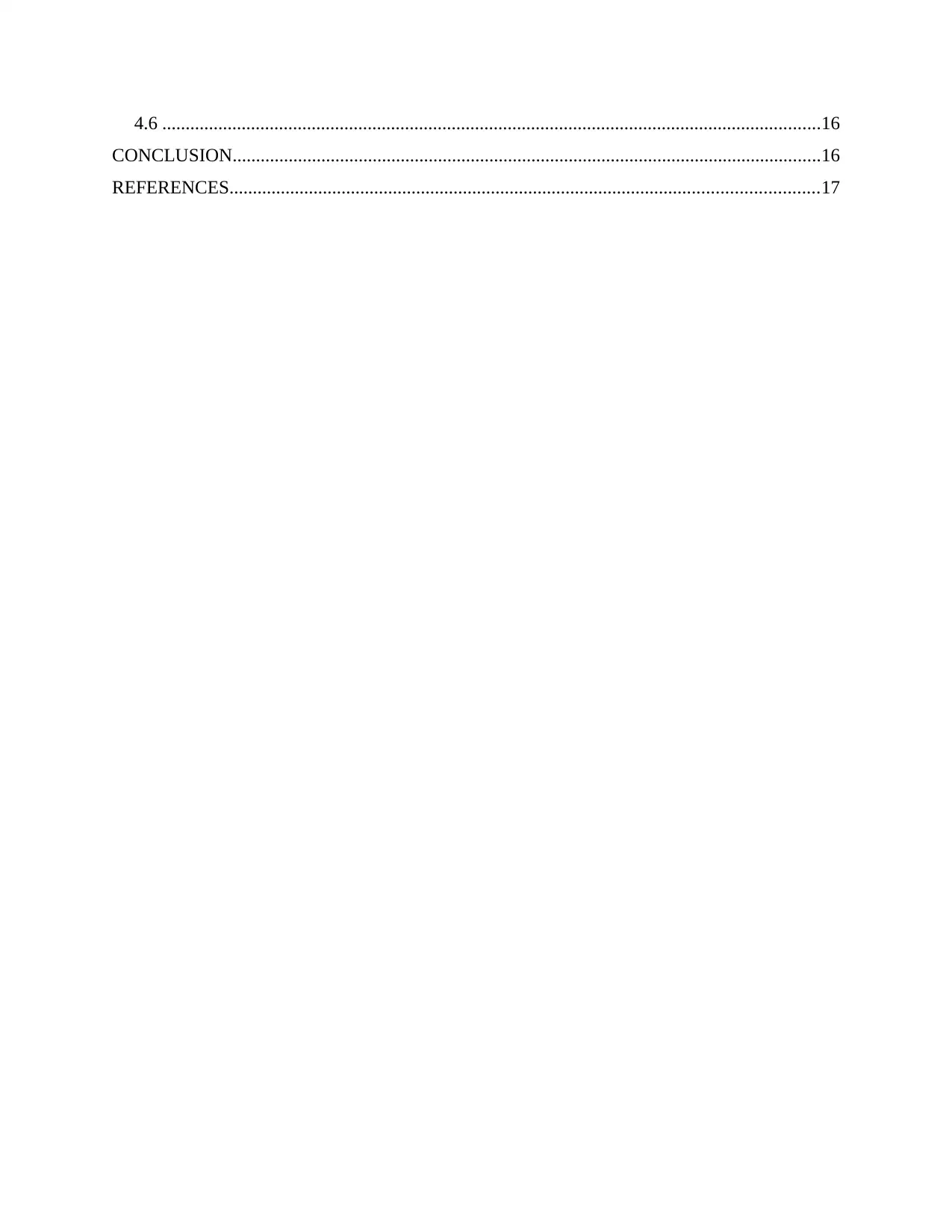
4.6 .............................................................................................................................................16
CONCLUSION..............................................................................................................................16
REFERENCES..............................................................................................................................17
CONCLUSION..............................................................................................................................16
REFERENCES..............................................................................................................................17
Paraphrase This Document
Need a fresh take? Get an instant paraphrase of this document with our AI Paraphraser
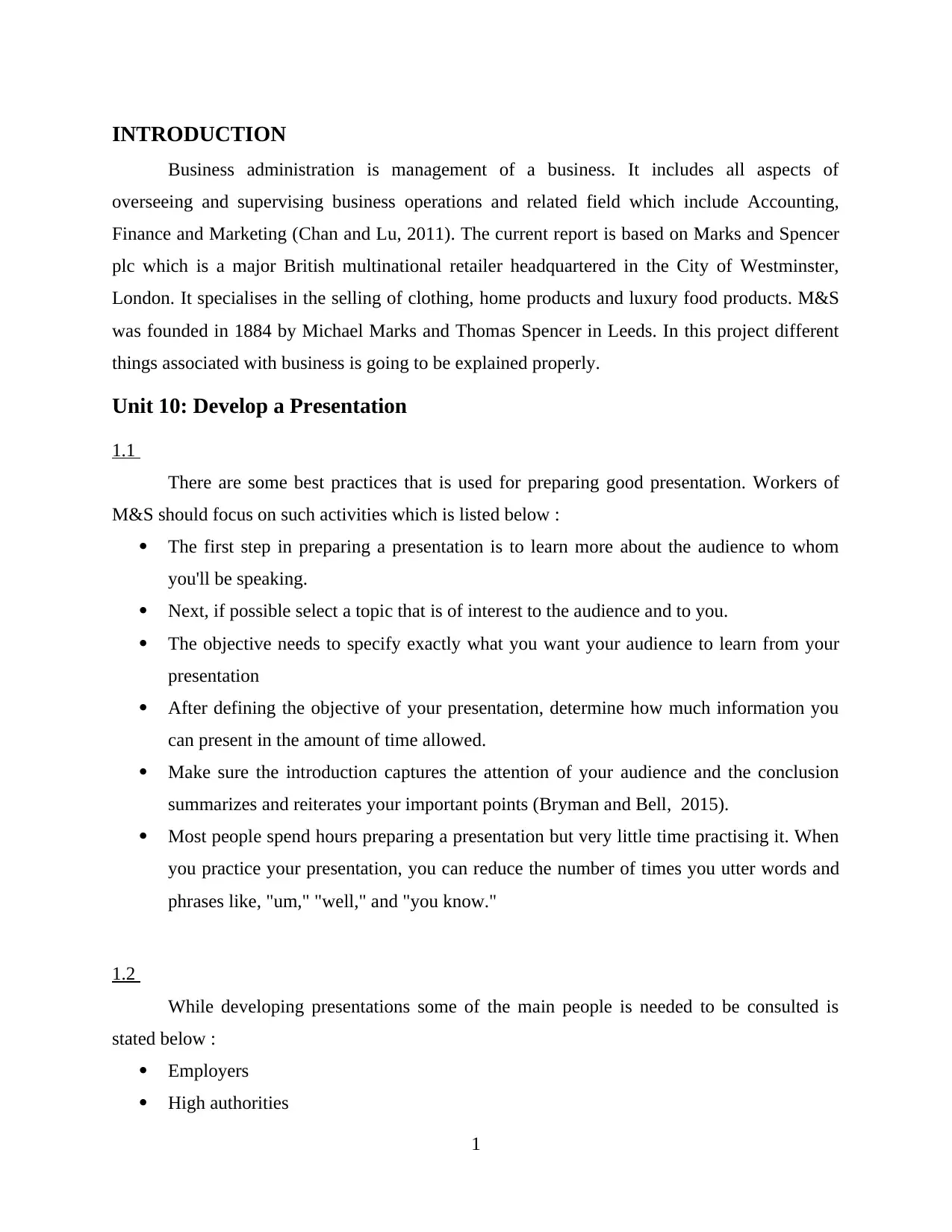
INTRODUCTION
Business administration is management of a business. It includes all aspects of
overseeing and supervising business operations and related field which include Accounting,
Finance and Marketing (Chan and Lu, 2011). The current report is based on Marks and Spencer
plc which is a major British multinational retailer headquartered in the City of Westminster,
London. It specialises in the selling of clothing, home products and luxury food products. M&S
was founded in 1884 by Michael Marks and Thomas Spencer in Leeds. In this project different
things associated with business is going to be explained properly.
Unit 10: Develop a Presentation
1.1
There are some best practices that is used for preparing good presentation. Workers of
M&S should focus on such activities which is listed below :
The first step in preparing a presentation is to learn more about the audience to whom
you'll be speaking.
Next, if possible select a topic that is of interest to the audience and to you.
The objective needs to specify exactly what you want your audience to learn from your
presentation
After defining the objective of your presentation, determine how much information you
can present in the amount of time allowed.
Make sure the introduction captures the attention of your audience and the conclusion
summarizes and reiterates your important points (Bryman and Bell, 2015).
Most people spend hours preparing a presentation but very little time practising it. When
you practice your presentation, you can reduce the number of times you utter words and
phrases like, "um," "well," and "you know."
1.2
While developing presentations some of the main people is needed to be consulted is
stated below :
Employers
High authorities
1
Business administration is management of a business. It includes all aspects of
overseeing and supervising business operations and related field which include Accounting,
Finance and Marketing (Chan and Lu, 2011). The current report is based on Marks and Spencer
plc which is a major British multinational retailer headquartered in the City of Westminster,
London. It specialises in the selling of clothing, home products and luxury food products. M&S
was founded in 1884 by Michael Marks and Thomas Spencer in Leeds. In this project different
things associated with business is going to be explained properly.
Unit 10: Develop a Presentation
1.1
There are some best practices that is used for preparing good presentation. Workers of
M&S should focus on such activities which is listed below :
The first step in preparing a presentation is to learn more about the audience to whom
you'll be speaking.
Next, if possible select a topic that is of interest to the audience and to you.
The objective needs to specify exactly what you want your audience to learn from your
presentation
After defining the objective of your presentation, determine how much information you
can present in the amount of time allowed.
Make sure the introduction captures the attention of your audience and the conclusion
summarizes and reiterates your important points (Bryman and Bell, 2015).
Most people spend hours preparing a presentation but very little time practising it. When
you practice your presentation, you can reduce the number of times you utter words and
phrases like, "um," "well," and "you know."
1.2
While developing presentations some of the main people is needed to be consulted is
stated below :
Employers
High authorities
1
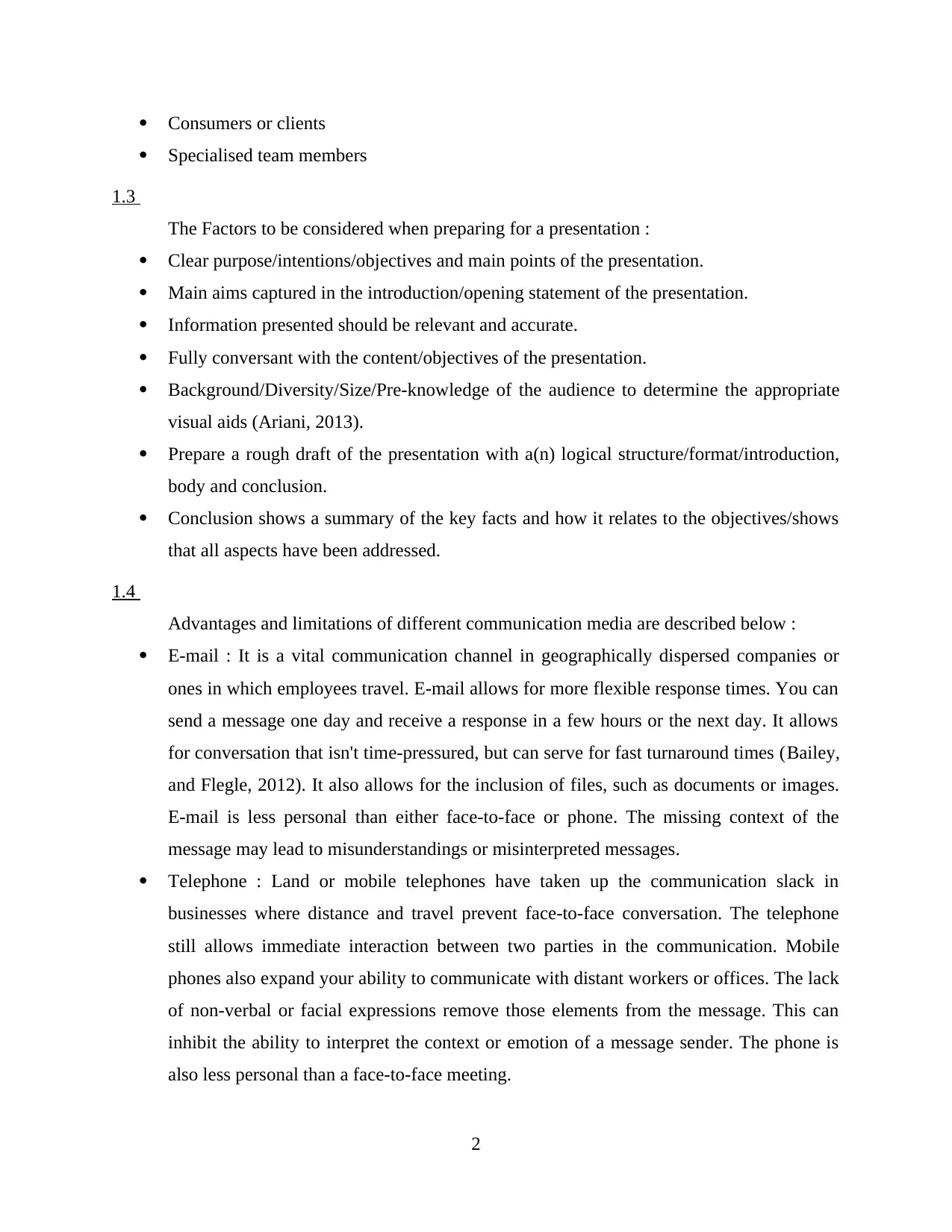
Consumers or clients
Specialised team members
1.3
The Factors to be considered when preparing for a presentation :
Clear purpose/intentions/objectives and main points of the presentation.
Main aims captured in the introduction/opening statement of the presentation.
Information presented should be relevant and accurate.
Fully conversant with the content/objectives of the presentation.
Background/Diversity/Size/Pre-knowledge of the audience to determine the appropriate
visual aids (Ariani, 2013).
Prepare a rough draft of the presentation with a(n) logical structure/format/introduction,
body and conclusion.
Conclusion shows a summary of the key facts and how it relates to the objectives/shows
that all aspects have been addressed.
1.4
Advantages and limitations of different communication media are described below :
E-mail : It is a vital communication channel in geographically dispersed companies or
ones in which employees travel. E-mail allows for more flexible response times. You can
send a message one day and receive a response in a few hours or the next day. It allows
for conversation that isn't time-pressured, but can serve for fast turnaround times (Bailey,
and Flegle, 2012). It also allows for the inclusion of files, such as documents or images.
E-mail is less personal than either face-to-face or phone. The missing context of the
message may lead to misunderstandings or misinterpreted messages.
Telephone : Land or mobile telephones have taken up the communication slack in
businesses where distance and travel prevent face-to-face conversation. The telephone
still allows immediate interaction between two parties in the communication. Mobile
phones also expand your ability to communicate with distant workers or offices. The lack
of non-verbal or facial expressions remove those elements from the message. This can
inhibit the ability to interpret the context or emotion of a message sender. The phone is
also less personal than a face-to-face meeting.
2
Specialised team members
1.3
The Factors to be considered when preparing for a presentation :
Clear purpose/intentions/objectives and main points of the presentation.
Main aims captured in the introduction/opening statement of the presentation.
Information presented should be relevant and accurate.
Fully conversant with the content/objectives of the presentation.
Background/Diversity/Size/Pre-knowledge of the audience to determine the appropriate
visual aids (Ariani, 2013).
Prepare a rough draft of the presentation with a(n) logical structure/format/introduction,
body and conclusion.
Conclusion shows a summary of the key facts and how it relates to the objectives/shows
that all aspects have been addressed.
1.4
Advantages and limitations of different communication media are described below :
E-mail : It is a vital communication channel in geographically dispersed companies or
ones in which employees travel. E-mail allows for more flexible response times. You can
send a message one day and receive a response in a few hours or the next day. It allows
for conversation that isn't time-pressured, but can serve for fast turnaround times (Bailey,
and Flegle, 2012). It also allows for the inclusion of files, such as documents or images.
E-mail is less personal than either face-to-face or phone. The missing context of the
message may lead to misunderstandings or misinterpreted messages.
Telephone : Land or mobile telephones have taken up the communication slack in
businesses where distance and travel prevent face-to-face conversation. The telephone
still allows immediate interaction between two parties in the communication. Mobile
phones also expand your ability to communicate with distant workers or offices. The lack
of non-verbal or facial expressions remove those elements from the message. This can
inhibit the ability to interpret the context or emotion of a message sender. The phone is
also less personal than a face-to-face meeting.
2
⊘ This is a preview!⊘
Do you want full access?
Subscribe today to unlock all pages.

Trusted by 1+ million students worldwide
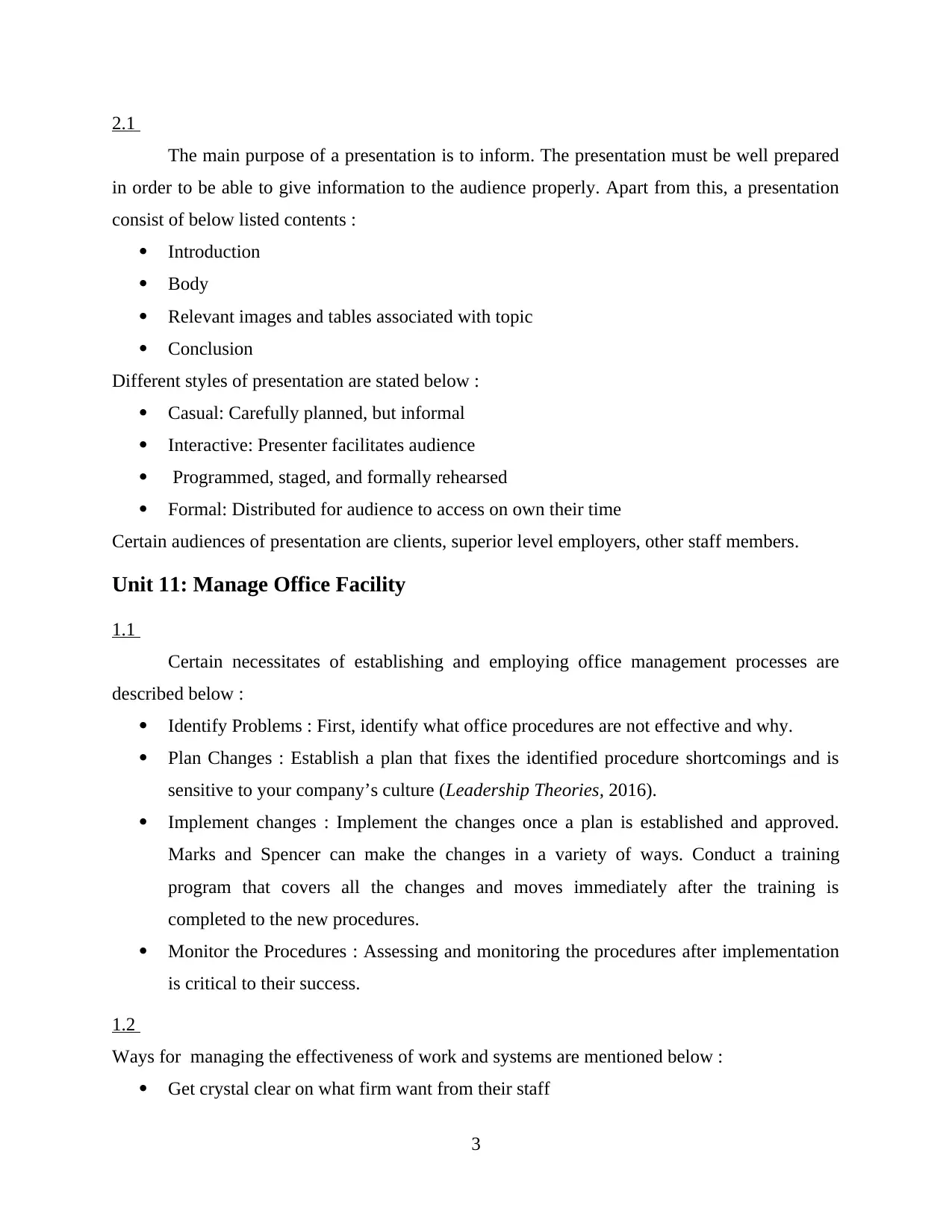
2.1
The main purpose of a presentation is to inform. The presentation must be well prepared
in order to be able to give information to the audience properly. Apart from this, a presentation
consist of below listed contents :
Introduction
Body
Relevant images and tables associated with topic
Conclusion
Different styles of presentation are stated below :
Casual: Carefully planned, but informal
Interactive: Presenter facilitates audience
Programmed, staged, and formally rehearsed
Formal: Distributed for audience to access on own their time
Certain audiences of presentation are clients, superior level employers, other staff members.
Unit 11: Manage Office Facility
1.1
Certain necessitates of establishing and employing office management processes are
described below :
Identify Problems : First, identify what office procedures are not effective and why.
Plan Changes : Establish a plan that fixes the identified procedure shortcomings and is
sensitive to your company’s culture (Leadership Theories, 2016).
Implement changes : Implement the changes once a plan is established and approved.
Marks and Spencer can make the changes in a variety of ways. Conduct a training
program that covers all the changes and moves immediately after the training is
completed to the new procedures.
Monitor the Procedures : Assessing and monitoring the procedures after implementation
is critical to their success.
1.2
Ways for managing the effectiveness of work and systems are mentioned below :
Get crystal clear on what firm want from their staff
3
The main purpose of a presentation is to inform. The presentation must be well prepared
in order to be able to give information to the audience properly. Apart from this, a presentation
consist of below listed contents :
Introduction
Body
Relevant images and tables associated with topic
Conclusion
Different styles of presentation are stated below :
Casual: Carefully planned, but informal
Interactive: Presenter facilitates audience
Programmed, staged, and formally rehearsed
Formal: Distributed for audience to access on own their time
Certain audiences of presentation are clients, superior level employers, other staff members.
Unit 11: Manage Office Facility
1.1
Certain necessitates of establishing and employing office management processes are
described below :
Identify Problems : First, identify what office procedures are not effective and why.
Plan Changes : Establish a plan that fixes the identified procedure shortcomings and is
sensitive to your company’s culture (Leadership Theories, 2016).
Implement changes : Implement the changes once a plan is established and approved.
Marks and Spencer can make the changes in a variety of ways. Conduct a training
program that covers all the changes and moves immediately after the training is
completed to the new procedures.
Monitor the Procedures : Assessing and monitoring the procedures after implementation
is critical to their success.
1.2
Ways for managing the effectiveness of work and systems are mentioned below :
Get crystal clear on what firm want from their staff
3
Paraphrase This Document
Need a fresh take? Get an instant paraphrase of this document with our AI Paraphraser
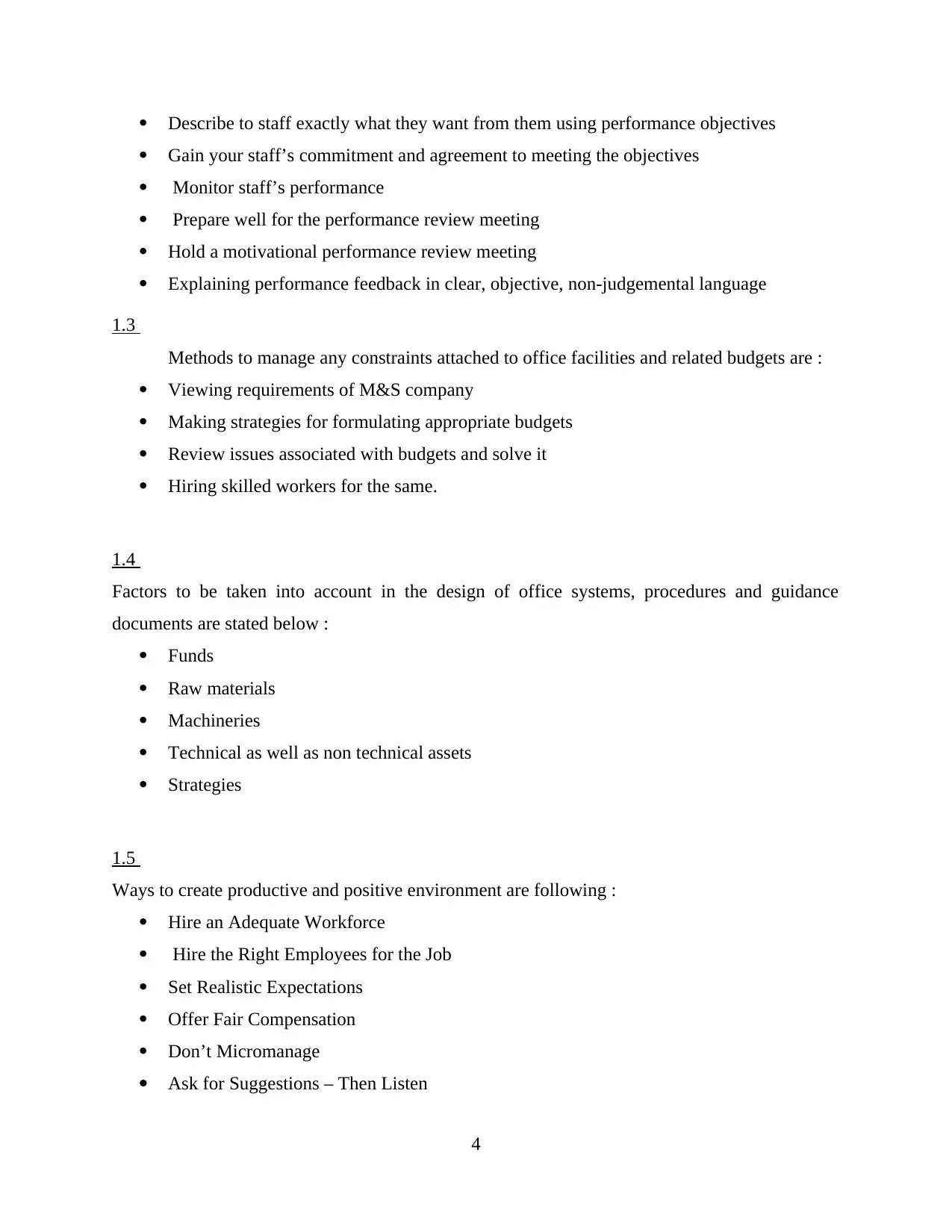
Describe to staff exactly what they want from them using performance objectives
Gain your staff’s commitment and agreement to meeting the objectives
Monitor staff’s performance
Prepare well for the performance review meeting
Hold a motivational performance review meeting
Explaining performance feedback in clear, objective, non-judgemental language
1.3
Methods to manage any constraints attached to office facilities and related budgets are :
Viewing requirements of M&S company
Making strategies for formulating appropriate budgets
Review issues associated with budgets and solve it
Hiring skilled workers for the same.
1.4
Factors to be taken into account in the design of office systems, procedures and guidance
documents are stated below :
Funds
Raw materials
Machineries
Technical as well as non technical assets
Strategies
1.5
Ways to create productive and positive environment are following :
Hire an Adequate Workforce
Hire the Right Employees for the Job
Set Realistic Expectations
Offer Fair Compensation
Don’t Micromanage
Ask for Suggestions – Then Listen
4
Gain your staff’s commitment and agreement to meeting the objectives
Monitor staff’s performance
Prepare well for the performance review meeting
Hold a motivational performance review meeting
Explaining performance feedback in clear, objective, non-judgemental language
1.3
Methods to manage any constraints attached to office facilities and related budgets are :
Viewing requirements of M&S company
Making strategies for formulating appropriate budgets
Review issues associated with budgets and solve it
Hiring skilled workers for the same.
1.4
Factors to be taken into account in the design of office systems, procedures and guidance
documents are stated below :
Funds
Raw materials
Machineries
Technical as well as non technical assets
Strategies
1.5
Ways to create productive and positive environment are following :
Hire an Adequate Workforce
Hire the Right Employees for the Job
Set Realistic Expectations
Offer Fair Compensation
Don’t Micromanage
Ask for Suggestions – Then Listen
4
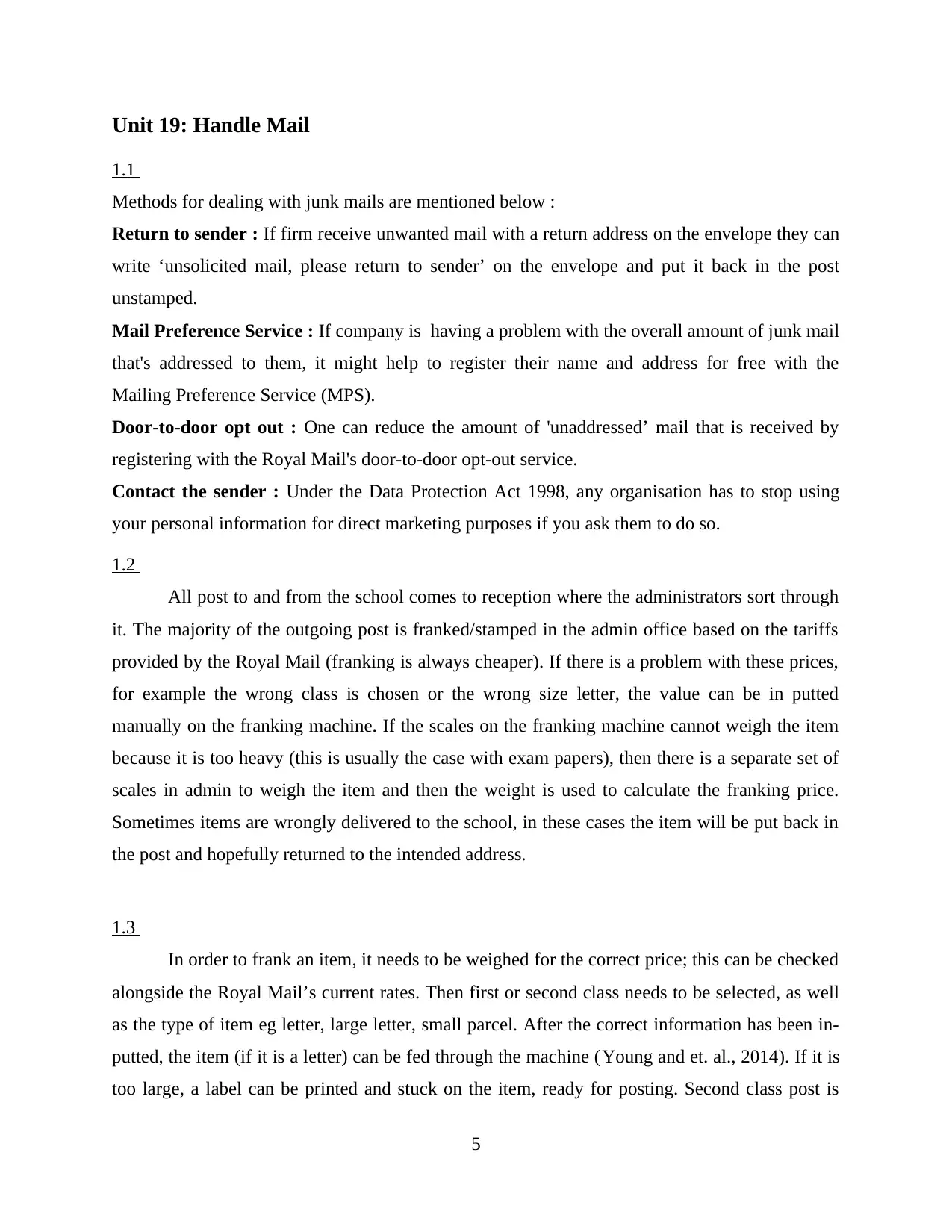
Unit 19: Handle Mail
1.1
Methods for dealing with junk mails are mentioned below :
Return to sender : If firm receive unwanted mail with a return address on the envelope they can
write ‘unsolicited mail, please return to sender’ on the envelope and put it back in the post
unstamped.
Mail Preference Service : If company is having a problem with the overall amount of junk mail
that's addressed to them, it might help to register their name and address for free with the
Mailing Preference Service (MPS).
Door-to-door opt out : One can reduce the amount of 'unaddressed’ mail that is received by
registering with the Royal Mail's door-to-door opt-out service.
Contact the sender : Under the Data Protection Act 1998, any organisation has to stop using
your personal information for direct marketing purposes if you ask them to do so.
1.2
All post to and from the school comes to reception where the administrators sort through
it. The majority of the outgoing post is franked/stamped in the admin office based on the tariffs
provided by the Royal Mail (franking is always cheaper). If there is a problem with these prices,
for example the wrong class is chosen or the wrong size letter, the value can be in putted
manually on the franking machine. If the scales on the franking machine cannot weigh the item
because it is too heavy (this is usually the case with exam papers), then there is a separate set of
scales in admin to weigh the item and then the weight is used to calculate the franking price.
Sometimes items are wrongly delivered to the school, in these cases the item will be put back in
the post and hopefully returned to the intended address.
1.3
In order to frank an item, it needs to be weighed for the correct price; this can be checked
alongside the Royal Mail’s current rates. Then first or second class needs to be selected, as well
as the type of item eg letter, large letter, small parcel. After the correct information has been in-
putted, the item (if it is a letter) can be fed through the machine (Young and et. al., 2014). If it is
too large, a label can be printed and stuck on the item, ready for posting. Second class post is
5
1.1
Methods for dealing with junk mails are mentioned below :
Return to sender : If firm receive unwanted mail with a return address on the envelope they can
write ‘unsolicited mail, please return to sender’ on the envelope and put it back in the post
unstamped.
Mail Preference Service : If company is having a problem with the overall amount of junk mail
that's addressed to them, it might help to register their name and address for free with the
Mailing Preference Service (MPS).
Door-to-door opt out : One can reduce the amount of 'unaddressed’ mail that is received by
registering with the Royal Mail's door-to-door opt-out service.
Contact the sender : Under the Data Protection Act 1998, any organisation has to stop using
your personal information for direct marketing purposes if you ask them to do so.
1.2
All post to and from the school comes to reception where the administrators sort through
it. The majority of the outgoing post is franked/stamped in the admin office based on the tariffs
provided by the Royal Mail (franking is always cheaper). If there is a problem with these prices,
for example the wrong class is chosen or the wrong size letter, the value can be in putted
manually on the franking machine. If the scales on the franking machine cannot weigh the item
because it is too heavy (this is usually the case with exam papers), then there is a separate set of
scales in admin to weigh the item and then the weight is used to calculate the franking price.
Sometimes items are wrongly delivered to the school, in these cases the item will be put back in
the post and hopefully returned to the intended address.
1.3
In order to frank an item, it needs to be weighed for the correct price; this can be checked
alongside the Royal Mail’s current rates. Then first or second class needs to be selected, as well
as the type of item eg letter, large letter, small parcel. After the correct information has been in-
putted, the item (if it is a letter) can be fed through the machine (Young and et. al., 2014). If it is
too large, a label can be printed and stuck on the item, ready for posting. Second class post is
5
⊘ This is a preview!⊘
Do you want full access?
Subscribe today to unlock all pages.

Trusted by 1+ million students worldwide
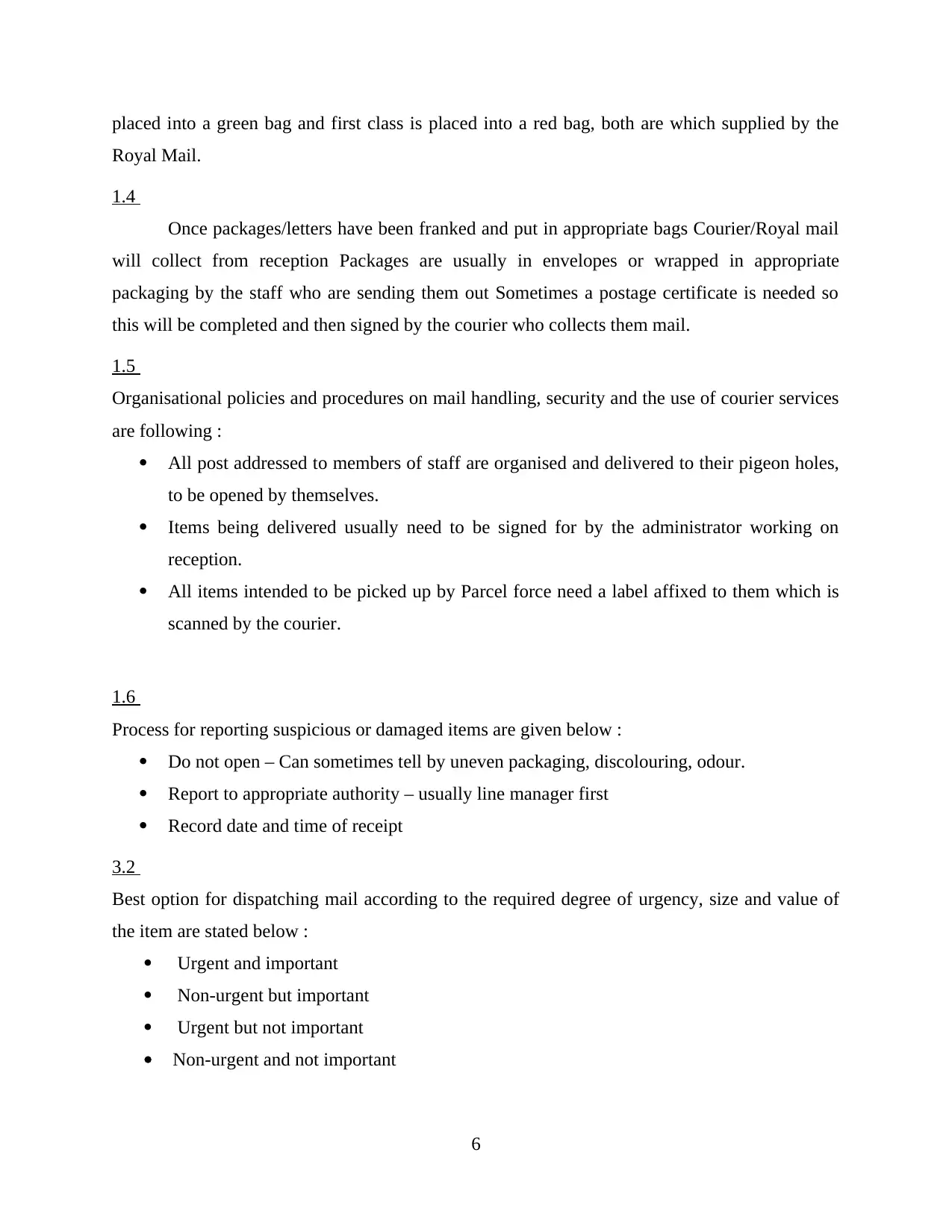
placed into a green bag and first class is placed into a red bag, both are which supplied by the
Royal Mail.
1.4
Once packages/letters have been franked and put in appropriate bags Courier/Royal mail
will collect from reception Packages are usually in envelopes or wrapped in appropriate
packaging by the staff who are sending them out Sometimes a postage certificate is needed so
this will be completed and then signed by the courier who collects them mail.
1.5
Organisational policies and procedures on mail handling, security and the use of courier services
are following :
All post addressed to members of staff are organised and delivered to their pigeon holes,
to be opened by themselves.
Items being delivered usually need to be signed for by the administrator working on
reception.
All items intended to be picked up by Parcel force need a label affixed to them which is
scanned by the courier.
1.6
Process for reporting suspicious or damaged items are given below :
Do not open – Can sometimes tell by uneven packaging, discolouring, odour.
Report to appropriate authority – usually line manager first
Record date and time of receipt
3.2
Best option for dispatching mail according to the required degree of urgency, size and value of
the item are stated below :
Urgent and important
Non-urgent but important
Urgent but not important
Non-urgent and not important
6
Royal Mail.
1.4
Once packages/letters have been franked and put in appropriate bags Courier/Royal mail
will collect from reception Packages are usually in envelopes or wrapped in appropriate
packaging by the staff who are sending them out Sometimes a postage certificate is needed so
this will be completed and then signed by the courier who collects them mail.
1.5
Organisational policies and procedures on mail handling, security and the use of courier services
are following :
All post addressed to members of staff are organised and delivered to their pigeon holes,
to be opened by themselves.
Items being delivered usually need to be signed for by the administrator working on
reception.
All items intended to be picked up by Parcel force need a label affixed to them which is
scanned by the courier.
1.6
Process for reporting suspicious or damaged items are given below :
Do not open – Can sometimes tell by uneven packaging, discolouring, odour.
Report to appropriate authority – usually line manager first
Record date and time of receipt
3.2
Best option for dispatching mail according to the required degree of urgency, size and value of
the item are stated below :
Urgent and important
Non-urgent but important
Urgent but not important
Non-urgent and not important
6
Paraphrase This Document
Need a fresh take? Get an instant paraphrase of this document with our AI Paraphraser
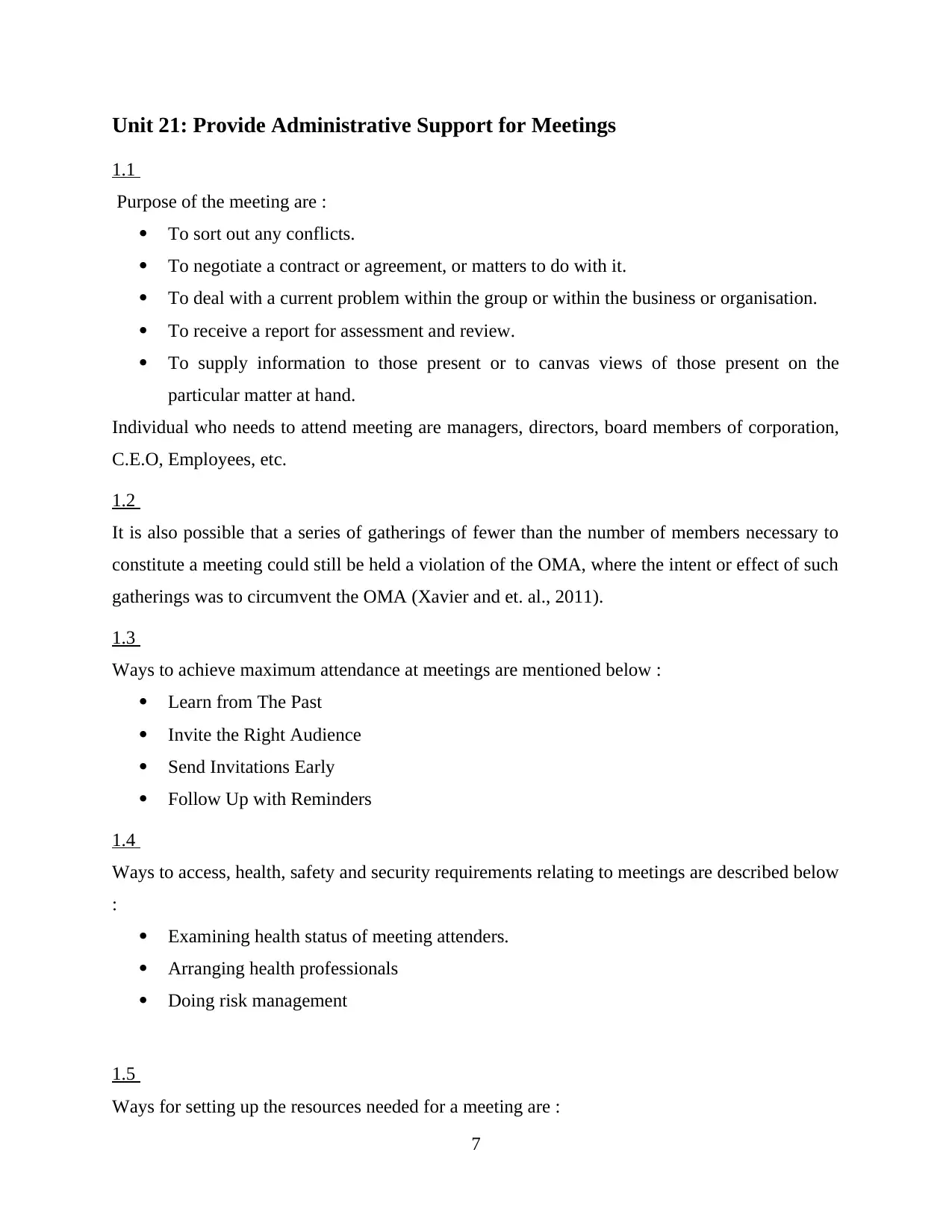
Unit 21: Provide Administrative Support for Meetings
1.1
Purpose of the meeting are :
To sort out any conflicts.
To negotiate a contract or agreement, or matters to do with it.
To deal with a current problem within the group or within the business or organisation.
To receive a report for assessment and review.
To supply information to those present or to canvas views of those present on the
particular matter at hand.
Individual who needs to attend meeting are managers, directors, board members of corporation,
C.E.O, Employees, etc.
1.2
It is also possible that a series of gatherings of fewer than the number of members necessary to
constitute a meeting could still be held a violation of the OMA, where the intent or effect of such
gatherings was to circumvent the OMA (Xavier and et. al., 2011).
1.3
Ways to achieve maximum attendance at meetings are mentioned below :
Learn from The Past
Invite the Right Audience
Send Invitations Early
Follow Up with Reminders
1.4
Ways to access, health, safety and security requirements relating to meetings are described below
:
Examining health status of meeting attenders.
Arranging health professionals
Doing risk management
1.5
Ways for setting up the resources needed for a meeting are :
7
1.1
Purpose of the meeting are :
To sort out any conflicts.
To negotiate a contract or agreement, or matters to do with it.
To deal with a current problem within the group or within the business or organisation.
To receive a report for assessment and review.
To supply information to those present or to canvas views of those present on the
particular matter at hand.
Individual who needs to attend meeting are managers, directors, board members of corporation,
C.E.O, Employees, etc.
1.2
It is also possible that a series of gatherings of fewer than the number of members necessary to
constitute a meeting could still be held a violation of the OMA, where the intent or effect of such
gatherings was to circumvent the OMA (Xavier and et. al., 2011).
1.3
Ways to achieve maximum attendance at meetings are mentioned below :
Learn from The Past
Invite the Right Audience
Send Invitations Early
Follow Up with Reminders
1.4
Ways to access, health, safety and security requirements relating to meetings are described below
:
Examining health status of meeting attenders.
Arranging health professionals
Doing risk management
1.5
Ways for setting up the resources needed for a meeting are :
7
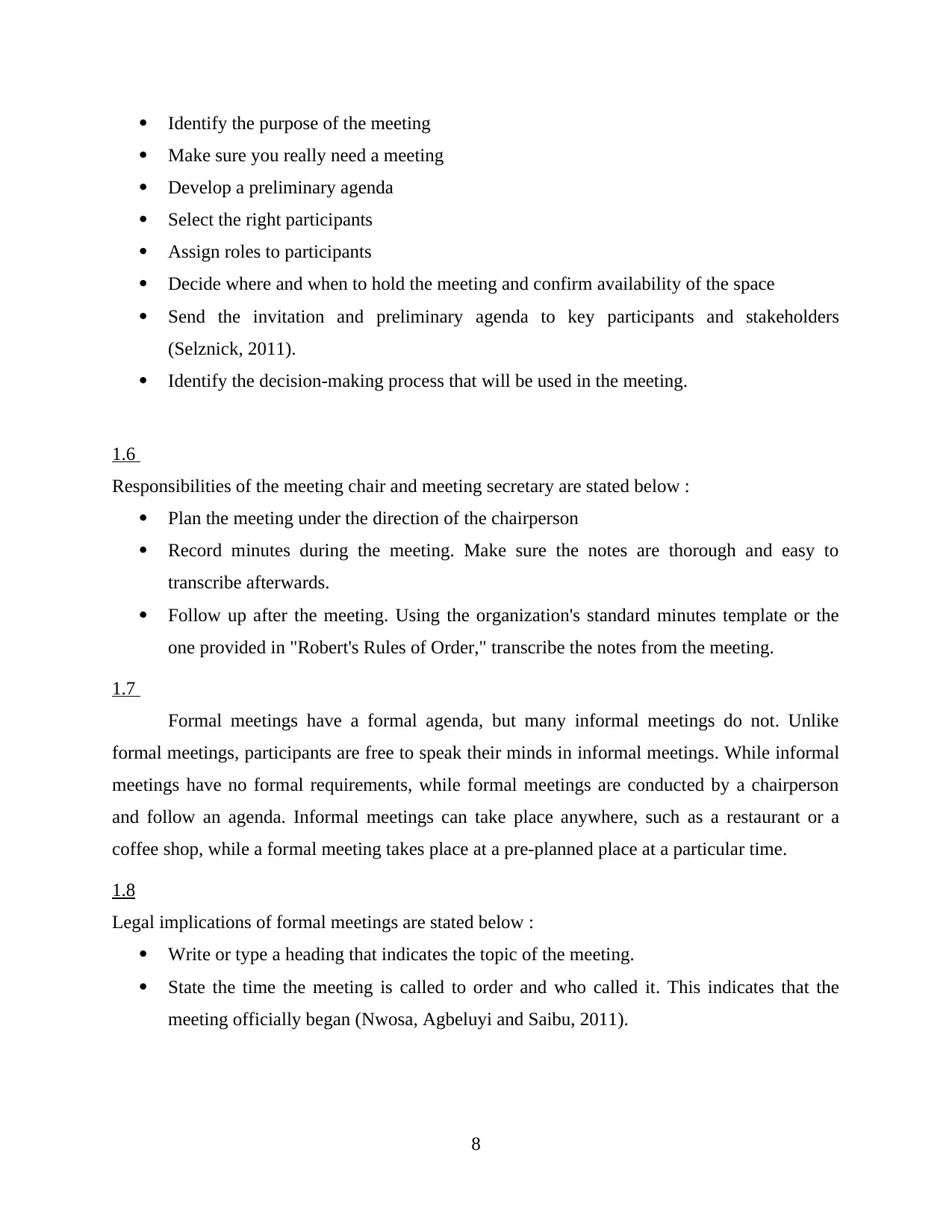
Identify the purpose of the meeting
Make sure you really need a meeting
Develop a preliminary agenda
Select the right participants
Assign roles to participants
Decide where and when to hold the meeting and confirm availability of the space
Send the invitation and preliminary agenda to key participants and stakeholders
(Selznick, 2011).
Identify the decision-making process that will be used in the meeting.
1.6
Responsibilities of the meeting chair and meeting secretary are stated below :
Plan the meeting under the direction of the chairperson
Record minutes during the meeting. Make sure the notes are thorough and easy to
transcribe afterwards.
Follow up after the meeting. Using the organization's standard minutes template or the
one provided in "Robert's Rules of Order," transcribe the notes from the meeting.
1.7
Formal meetings have a formal agenda, but many informal meetings do not. Unlike
formal meetings, participants are free to speak their minds in informal meetings. While informal
meetings have no formal requirements, while formal meetings are conducted by a chairperson
and follow an agenda. Informal meetings can take place anywhere, such as a restaurant or a
coffee shop, while a formal meeting takes place at a pre-planned place at a particular time.
1.8
Legal implications of formal meetings are stated below :
Write or type a heading that indicates the topic of the meeting.
State the time the meeting is called to order and who called it. This indicates that the
meeting officially began (Nwosa, Agbeluyi and Saibu, 2011).
8
Make sure you really need a meeting
Develop a preliminary agenda
Select the right participants
Assign roles to participants
Decide where and when to hold the meeting and confirm availability of the space
Send the invitation and preliminary agenda to key participants and stakeholders
(Selznick, 2011).
Identify the decision-making process that will be used in the meeting.
1.6
Responsibilities of the meeting chair and meeting secretary are stated below :
Plan the meeting under the direction of the chairperson
Record minutes during the meeting. Make sure the notes are thorough and easy to
transcribe afterwards.
Follow up after the meeting. Using the organization's standard minutes template or the
one provided in "Robert's Rules of Order," transcribe the notes from the meeting.
1.7
Formal meetings have a formal agenda, but many informal meetings do not. Unlike
formal meetings, participants are free to speak their minds in informal meetings. While informal
meetings have no formal requirements, while formal meetings are conducted by a chairperson
and follow an agenda. Informal meetings can take place anywhere, such as a restaurant or a
coffee shop, while a formal meeting takes place at a pre-planned place at a particular time.
1.8
Legal implications of formal meetings are stated below :
Write or type a heading that indicates the topic of the meeting.
State the time the meeting is called to order and who called it. This indicates that the
meeting officially began (Nwosa, Agbeluyi and Saibu, 2011).
8
⊘ This is a preview!⊘
Do you want full access?
Subscribe today to unlock all pages.

Trusted by 1+ million students worldwide
1 out of 21
Related Documents
Your All-in-One AI-Powered Toolkit for Academic Success.
+13062052269
info@desklib.com
Available 24*7 on WhatsApp / Email
![[object Object]](/_next/static/media/star-bottom.7253800d.svg)
Unlock your academic potential
Copyright © 2020–2025 A2Z Services. All Rights Reserved. Developed and managed by ZUCOL.





